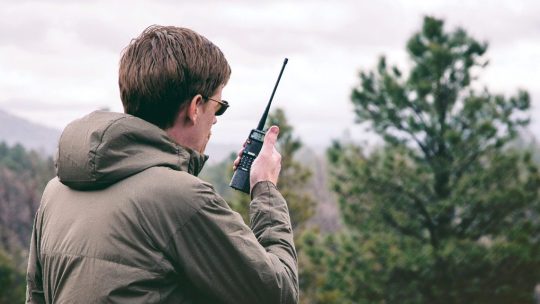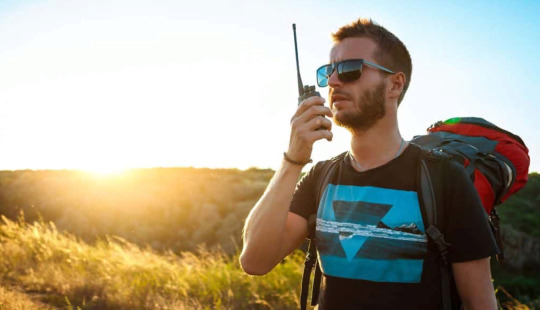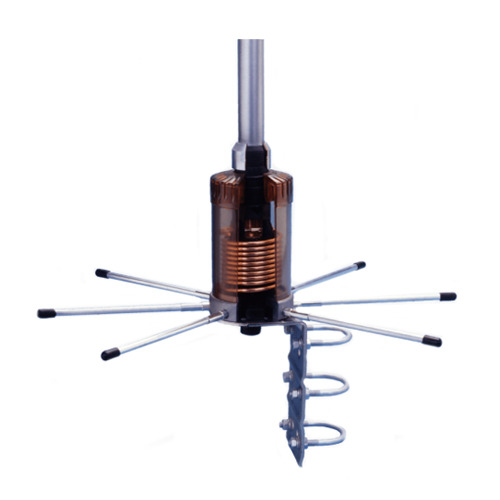Don't wanna be here? Send us removal request.
Text

A Best Short Guide To Walkie Talkies
On the off chance that you’ve never had the long range walkie talkies 100 miles, you don’t have the foggiest idea how much enjoyment you’ve been absent! Before cellphones got mainstream during the 1980s and 1990s, best rechargeable walkie talkies were the long range radio communication over short to medium ranges – they’re still generally utilized by cops, military faculty, and the coordinators of open occasions. What are they and how accomplish they work? We should investigate!
What is a Walkie Talkies?
Best walkie talkie without license, versatile radios: they impart remotely motorola commercial two-way radios on a solitary, shared recurrence band. Every battery-controlled unit contains a transmitter / recipient and receiving wire (for sending and accepting radio waves), an amplifier that regularly bends over as a receiver when you talk into it, and a catch that you are “push-to-talk” (PTT).
The amplifier/mouthpiece works similarly as a radio: on the grounds that a speaker and a receiver contain basically similar segments (a curl of wire, a magnet, and a paper or plastic cone to get or produce sounds), you can utilize a solitary gadget to do the two employments basically by exchanging the electrical circuit into which it’s associated and switching the flow. Progressively refined rechargeable walkie talkies 4 pack (like the Motorola model appeared in our photographs) contain separate amplifiers and receivers.
Who Invented Walkie Talkies?
Emergency frequency ham radio (initially called two-way radio use guidelines or “pack sets”) were created in 1937 by Canadian Donald Hings (1907 – 2004) and, around a similar time, by American innovator (Irving) Alfred Gross (1918 – 2000). The two men saw their creations produced for military use during World War II; both proceeded to devise various different innovations: Gross is credited with designing pagers, which were a well-known method for keeping in contact progressing before cellphones got omnipresent, while Hings built up various upgrades to the radio, radar, attractive ground-reviewing gadgets, and hardware for estimating air contamination (he has 39 unique developments recorded at the US Patent and Trademark Office).

What are the Advantages and Disadvantages of Walkie Talkies?
Advantages of a Walkie Talkie:
Long range walkie talkies 1000 miles, simple to-utilize, and straightforward (with generally hardly any parts and highlights), so they’re splendid for use outside and incredible for youngsters (or for kids who need to keep in contact with guardians, for instance, in the midst of a get-away). They’re especially helpful in places where cellphone organizes inclusion is poor or inaccessible (in fiascos or crises, for instance).
They’re additionally incredible enjoyment: kids love doing the “over” and “over and out” business. They’re extremely convenient in circumstances were heaps of individuals need to tune in and just a single need to talk without a moment’s delay (for instance, in case you’re offering directions to laborers on a campground).
They’re very advantageous, weighing only 100 – 200 g (3.5 – 7 oz); work over a better than average range (regularly 5 – 10 square km or 2 – 4 square miles); and have long battery life (20 hours on 3 – 4 battery-powered or basic batteries is run of the mill). Walkie talkies, by and large, have numerous channels (from around 8 to at least 25) so you can without much of a stretch change to another recurrence if others are likewise utilizing walkie talkies close by. Some best walkie talkie for hunting can likewise be utilized as child screen long range walkie talkies 1000 miles.
Disadvantages of a Walkie Talkies:
Most reasonable walkie talkies are simple units, so they’re dependent upon obstruction and moderately simple to spy (increasingly costly computerized units get around impedance, however for the most part walkie talkie building london melts car to defeat listening stealthily). Walkie talkies are not intended for correspondence over longer ranges (for which you’ll require something like CB radio or a cellphone).

How Do You Use Walkie Talkies ?
A gathering of individuals who are utilizing walkie talkie communication to converse with each other needs to check out a similar recurrence band, which is known as a channel.
Their radios are all “receiving,” so their mouthpiece/amplifier units are filling in as amplifiers and presumably murmuring with static, somewhat like a traditional radio that is not tuned in to a specific station.
At the point when somebody needs to converse with the others, they hold the press-to-talk button on their handset. Their two way radio hire goes tranquil as their amplifier switches over to a receiver. As they talk into it, their words are changed over into radio waves and transmitted out on the prearranged channel (normally at a recurrence around 460 MHz).
Since radio waves are a piece of the electromagnetic range, they travel at the speed of light (300,000 km/second or 186,000 miles / second), so the waves are gotten promptly by different handsets. The radio waves are changed over go into fluctuating electric flows and the amplifiers utilize those to repeat the sound of the talker’s voice.
At the point when the talker has completed, the person in question says “over” (which means my bit of talking is done) and discharges the press-to-talk button. The radio currently switches once again into listening mode and another person can talk.
In contrast to an ordinary radio, which will just get communicate voices or music from a radio station, a how to use walkie talkie on apple watch you can both talk and tune in (send and get).
The fundamental disadvantage is that a similar recurrence channel is utilized for the two things, so just a single individual can talk at once. At the point when specialized gadgets work along these lines, they’re portrayed as half-duplex (a solitary channel permits correspondence in just a single bearing at any one time), rather than full-duplex (where you can talk and tune in simultaneously, as on a phone).
0 notes
Text
MFJ-9017 – 17 Meter CW Transceiver

Easy Operation: The most user-friendly radio you’ll ever own. Sets up in seconds – no microprocessor mumbo jumbo.
Great Sensitivity: New hotter than ever superhet receiver brings weakest signals in at full volume (super-quiet FET post amp stage in the IF filter makes this the best CW receiver going).
Excellent Selectivity: Tight CW bandwidth crystal ladder filter fights unwanted QRM and noise to the maximum.
Smooth and Stable VFO: Wide-spaced reduction drive VFO capacitor glides slowly across the easy-to-read dial.
True RIT: RIT control has centre detent – makes listening or calling off-frequency a snap.
Easy on Your Ears: Smooth AGC tracks only the signals you want to hear – it never locks onto strong signals outside the audio bandpass. MFJS Instant Recovery AGC snaps the receiver back at a full gain after transmitting.
Built-in Speaker: High efficiency 3″ speaker driven by 100 MW of audio gives great volume.
Rugged Transmitter: Motorola power amplifier transistor delivers full QRP output, and tolerates opens and accidental shorts without damage.
Sine Wave, Side Tone: Pure 700 Hz CW sidetone makes sending as much fun as receiving!
Semi-QSK: Set adjustable hold transmit / receive switching to suit your normal sending speed or set it for full QSK during contests.
Easy to Power: It uses little power – only 50 MA average on receive and 1.2 amp peak on transmit. Perfect for battery operation in remote locations!
Rugged Construction: MFJ CW radios are built on G-10 double-sided plated-through PC boards in our plant. Rugged all-metal cabinet with the brushed aluminium front panel and vinyl clad cover.
0 notes
Text
Sirio 2008 Base Antenna (26 – 28.2 MHz) (CB & 10M Amateur Bands)

Specification
CB or 10 metre amateur base station antenna, omnidirectional
High power handling capability
Low radiation angle for excellent DX
Coil protected by transparent cover
Whip equipped with waterproof jointing sleeve
Equipped with excellent multi element ground plane
Protection from static discharges DC-Ground
Made of aluminium alloy 6063 T-832
Electrical Data
Type: 5/8 wave ground plane
Frequency range: tunable from 26.4 to 28.2 MHz
Impedance: 50 Ohms
Radiation (H-plane): 360° omnidirectional
Polarization: linear vertical
Gain: 1.3 dBd, 3.45 dBi
Max Power:
1000 Watts (CW) continuous, 3000 Watts (CW) short time
Feed System / Position: Transformer DC-ground / base
Connector: UHF-female
Mechanical Data
Materials: Aluminium, Copper, Nylon
Wind Load / Resistance: 166N at 150 km/h / 130 km/h
Wind surface: 0.14 m²
Height: 6100 mm
Weight: 5300 g
Radial Length: 1320 mm
Mounting Mast: Ø 40 – 50 mm
1 note
·
View note